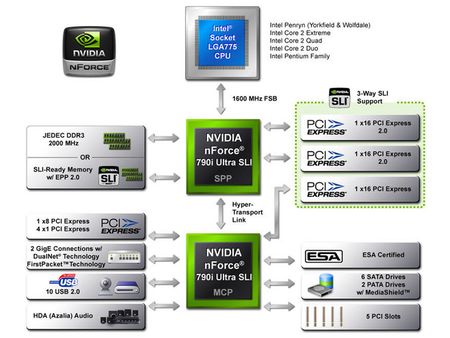High-End Chipset Battle
Nvidia nForce 790i Ultra SLI
Unlike Intel’s strict split between enthusiast products (X48) and the mainstream line (P35, G35), Nvidia has a more comprehensive chipset portfolio. The nForce 790i Ultra SLI, as reviewed in this article, is the top model for enthusiasts. The key feature for the Ultra version is SLI-ready memory support, which goes as high as DDR3-2000 speeds. None of the nForce 790i chipset versions supports DDR2, only DDR3. The nForce 790i SLI (non-Ultra) also supports SLI-ready memory, but only up to DDR3-1333. FSB1600 support is available with both 790i SLI versions.
Apart from the 790i flagships, the nForce models 680i and 780i also support three-way SLI (twin x16 PCI Express 2.0 plus one x16 PCI Express 1.0 slot), but these go with DDR2 memory instead of DDR3. There is SLI-ready memory support for automatic settings of ideal RAM clock speed and timings, which is limited to DDR2-1200 speed. Since there won’t be much faster DDR2 memory, this is more than adequate.
Finally, there is an nForce 750i SLI entry-level model, which is limited to two x8 PCI Express 2.0 slots, and so does not support three-way SLI. Memory support is restricted to DDR2-800, and SLI-ready memory is not supported. The nForce 750i has to live with one instead of two Gigabit LAN ports, and with only four instead of six SATA/300 plugs. While Intel is about to release single PCI Express 2.0 into the mainstream with P45 at Computex, the nForce 750i SLI is already there.
The block diagram of the 790i Ultra SLI is similar to that of Intel’s X48. The 790i Ultra SLI SPP northbridge (System Platform Processor) connects to the CPU via a 400 MHz quad data rate bus (FSB1600). There are as many as 62 PCI Express lanes; 2 x 16 of them are used by the northbridge to provide two x16 slots, the remainder are provided by the southbridge. The dual channel DDR3 memory controller supports speeds up to DDR3-2000, although SLI-ready DIMMs are necessary to have the system select ideal clock speeds and timings automatically.
While Intel connects its MCH and ICH via a 2 GB/s interface called the Direct Media Interface (DMI), Nvidia utilizes HyperTransport. This is particularly interesting since this is the interface that AMD uses to connect its processors and core logic — and it is being used on an Intel platform. However, HyperTransport is necessary, as the third x16 PCI Express slot for three-way SLI (using eight lanes) has to be provided by the Media and Communications Processor (MCP) southbridge.
The 790i Ultra SLI MCP provides two Gigabit Ethernet ports with teaming features, ten USB 2.0 ports (versus 12 ports with Intel), and six SATA/300 ports plus an UltraATA/133 channel for two legacy devices — Intel dropped support for parallel ATA with the introduction of the P35 chipset line. Nvidia also still supports up to five 32 bit PCI bus master slots for legacy expansion cards. High Definition audio is pretty much essential these days, so it doesn’t come as a surprise to find an appropriate unit on the MCP as well.
Get Tom's Hardware's best news and in-depth reviews, straight to your inbox.
